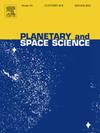Demonstration of the low-temperature carbothermal process for producing oxygen from lunar regolith: Terrestrial test campaign
IF 1.7
4区 物理与天体物理
Q3 ASTRONOMY & ASTROPHYSICS
引用次数: 0
Abstract
The solid-gas carbothermal reduction is one of the processes available for extracting oxygen from the lunar regolith, a crucial capability for supporting lunar exploration and establishing a sustainable human presence on the Moon’s surface. This article presents the findings of the experimental campaign conducted at the Politecnico di Milano, which confirmed the feasibility of the process. Water is extracted from dry regolith, and the production of carbon oxides is monitored to gather data on the process. The campaign studied the influence of various parameters to enhance water and oxygen production, including reaction temperatures, regolith granularity and mass, solid-to-gas ratio, processing duration, and others. The extracted water is collected in a condensation stage, while the evolution of the gaseous mixture is monitored using gas chromatography, and the exhaust batch of simulant is analysed through SEM and XRD. These analyses provided qualitative and quantitative assessments of the reaction’s effectiveness, yielding important information about the impact of changing parameters. The study concludes by proposing a set of process parameters to serve as a baseline for future implementation of the low-temperature carbothermal process on the lunar surface.
从月球风化层生产氧气的低温碳热过程的演示:陆地试验活动
固体-气体碳热还原是从月球风化层中提取氧气的一种方法,这是支持月球探测和在月球表面建立可持续人类存在的关键能力。本文介绍了在米兰理工大学进行的实验活动的结果,证实了该过程的可行性。从干燥的风化层中提取水,并监测碳氧化物的产生,以收集有关该过程的数据。该活动研究了各种参数对提高水和氧产量的影响,包括反应温度、风化层粒度和质量、固气比、处理时间等。在冷凝阶段收集提取的水,同时使用气相色谱法监测气体混合物的演变,并通过SEM和XRD分析模拟物的排气批次。这些分析提供了反应有效性的定性和定量评估,提供了关于参数变化影响的重要信息。该研究最后提出了一套工艺参数,作为未来在月球表面实施低温碳热过程的基线。
本文章由计算机程序翻译,如有差异,请以英文原文为准。
求助全文
约1分钟内获得全文
求助全文
来源期刊

Planetary and Space Science
地学天文-天文与天体物理
CiteScore
5.40
自引率
4.20%
发文量
126
审稿时长
15 weeks
期刊介绍:
Planetary and Space Science publishes original articles as well as short communications (letters). Ground-based and space-borne instrumentation and laboratory simulation of solar system processes are included. The following fields of planetary and solar system research are covered:
• Celestial mechanics, including dynamical evolution of the solar system, gravitational captures and resonances, relativistic effects, tracking and dynamics
• Cosmochemistry and origin, including all aspects of the formation and initial physical and chemical evolution of the solar system
• Terrestrial planets and satellites, including the physics of the interiors, geology and morphology of the surfaces, tectonics, mineralogy and dating
• Outer planets and satellites, including formation and evolution, remote sensing at all wavelengths and in situ measurements
• Planetary atmospheres, including formation and evolution, circulation and meteorology, boundary layers, remote sensing and laboratory simulation
• Planetary magnetospheres and ionospheres, including origin of magnetic fields, magnetospheric plasma and radiation belts, and their interaction with the sun, the solar wind and satellites
• Small bodies, dust and rings, including asteroids, comets and zodiacal light and their interaction with the solar radiation and the solar wind
• Exobiology, including origin of life, detection of planetary ecosystems and pre-biological phenomena in the solar system and laboratory simulations
• Extrasolar systems, including the detection and/or the detectability of exoplanets and planetary systems, their formation and evolution, the physical and chemical properties of the exoplanets
• History of planetary and space research
 求助内容:
求助内容: 应助结果提醒方式:
应助结果提醒方式:


